Beyond Possible: New BPS program links coding, robots and early college credits
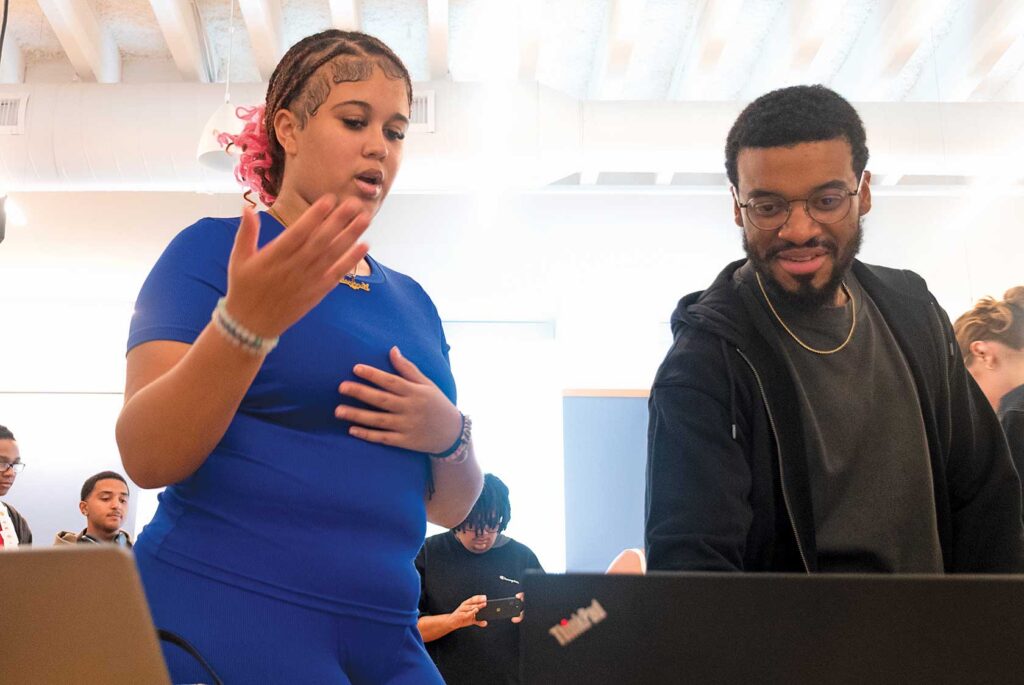
From the second floor of The Possible Zone’s red-brick innovation center in Jackson Square, a squadron of robots clicked and whirred as they chased down green balls in a tangled field of obstacles and sped around a racetrack constructed with blue painter’s tape.
At a showcase, Aug. 21, the robots piloted and pivoted, navigating by sensors and artificial intelligence programming, to an audience of 21 Boston Public Schools students who did the programming and a crowd of educators who came to watch a week’s-worth of hard work pay off at the showcase intended to get the students, all incoming juniors, familiar with computer coding.
The new skills and experiences that the students learned during the week-long program fell at the intersection of stressful and fun, said Giovanna Monteiro, a Madison Park Technical Vocational High School junior.
“The stress part is because the coding is very confusing; there’s some things that you think that would work, but then it doesn’t, or it doesn’t work the way you want it to,” Monteiro said. “But the fun part is just having people around helping you.”
Monteiro and the rest of the 21 BPS students make up a cohort who are preparing to start taking computer science courses through Wentworth Institute of Technology next month, as part of Beyond Possible, a new college pathways partnership between Boston Public Schools, Wentworth and The Possible Zone — an educational nonprofit that works with Boston Public Schools to provide hands-on science, technology, engineering, arts and mathematics activities.
The robot-coding bootcamp is part of the official start of the inaugural cohort, which was recruited in the spring semester and participated in a game design seminar through The Possible Zone.
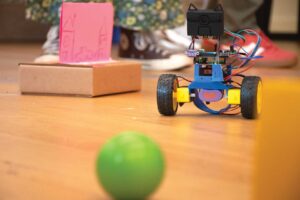
An autonomous robot tracks down a green ball during the showcase at The Possible Zone, PHOTO: AVERY BLEICHFELD
Over the next two school years, starting in September, the students, who attend four BPS high schools — English High School, Dr. Albert D. Holland High School of Technology, Madison Park Technical Vocational High School and John D. O’Bryant High School — will take part in four undergraduate computer science and data analytics courses through Wentworth, three classes through The Possible Zone, and spend parts of their summer shadowing and interning in the field.
Staff running the program said they’re hoping it will broaden the horizons and opportunities for more BPS students.
“The idea is that there just aren’t enough opportunities for students in Boston to have structured, supported college classes,” said Joanna Sanborn, vice president of post-secondary pathways at The Possible Zone. “This is really like a new effort to provide this in an after-school model.”
For some, the coursework might lead to a career in a coding field; for others, it might be a chance to explore related options.
Jeronimo Palacio, an O’Bryant junior, said that he’s heard that pursuing something like computer science in college requires a bigger commitment, but participating in Beyond Possible gives him a chance to see what options he might be interested in pursuing.
“That [big commitment] is just not me right now,” he said. “You know, I’m just experimenting with different stuff and just trying to figure out what I want to do and what I don’t want to do.”
For Sanborn, who has been working on getting the program up and running for a couple of years — conversations between the three partners began in late 2023 — seeing the rubber hit the road with the students and their autonomous robots is exciting.
The week-long summer program was a steppingstone, preparing the BPS students, who may not have had any prior experience with coding, for the undergraduate-level computer science classes they’ll be taking in the fall through the Wentworth partnership.
“We know that these students are smart and capable and motivated, they just need to be given the opportunity,” said Kate Stutz, director of college access and success at Wentworth. “I think this week has really been about giving them that opportunity and investing in them and believing in them and knowing that we can fully equip them to be successful.”
The autonomous robot curriculum was chosen because it gave the students hands-on experience to make the coding knowledge real and tactile, said Jeff Branson, vice president of STEAM industry and engagement at The Possible Zone.
“They have time to stop, do something with their hands, make changes to the code, and then see how what they did in the code actually behaves in the real world,” he said. “There’s this learning synthesis of, ‘I do this on the code, and this is what the behavior looks like.’”
Though the curriculum had some hiccups getting started — Branson, one of the instructors who led the course, said one version of the planned lessons was scrapped 10 days before class started because the hardware they were working with wasn’t working predictably enough and would be tough to teach — ultimately, it had success.
Of the two activities the students programmed their robots to create, the tape racetrack was an idea that was developed, without prompting, by the students.
“That was students going, if we can train it on green, can we train it on blue?” Branson said. “And I looked over and they were stretching tape out across the floor, and the robot was following the tape.”
As the program fully kicks off in September, the three partner organizations are pursuing an official “early college” designation with the state, which would bring in state funding for Wentworth to offer college credits and allow classes during the school day.
That initiative targets equitable access and creating pathways to college and career, with the intention of making college aspirations easier and less expensive. Students in the programs earn credits that count toward post-secondary degrees, specifically in communities that have historically been underrepresented in higher education.
A 2023 report from MassINC, using state data, reported that early college programs in the state increased the number of students attending college immediately after high school by 15 percentage points and doubled the share of students who remained in the college pipeline.
BPS currently has 11 schools with early college partnerships across higher education institutions including Bunker Hill Community College, the University of Massachusetts Boston, Benjamin Franklin Cummings Institute of Technology and Fisher College. Wentworth already has three early college partnerships with BPS high schools.
The Beyond Possible partnership, however, pushes the bounds on what is traditionally included in the state’s initiative, Sanborn said. Typically, those “early college” designations recognize one high school in collaboration with one college. The cohort model — four high schools, one university and a nonprofit — falls outside of that norm.
“Right now, it’s really limited to a partnership between a higher ed institution and a specific high school,” Stutz said. “By having a consortium model, we’re really able to offer a more consistent experience to more students, because it’s no longer dependent on where they end up going to high school.”
If approved, Sanborn said that it could help with recruitment to the program. In February, when recruiting students, staff from The Possible Zone said they were looking to pull 30 students from the four schools into the college pathways program; when they kicked off with the week-long bootcamp, they had recruited 21. Some of that, she said, may come from the commitment students have to make outside of school hours, while they balance other commitments.
“It makes us think that if we could push programs like this a little bit into the school day, I think it would remove even more barriers for students,” she said.
The process of applying for the designation is on the radar of the three organizations but is slow-moving until the official application period with the state in the spring. If successful, it would also mean recognition of the distinct model, which has the potential to unite multiple stakeholders.
“It’s worked because we’re all aligned on our values,” Sanborn said. “We really agreed, early on, what were the essential components of our partnership.”
That includes things like a commitment to a low barrier for entry, making it an accessible program to any student who wants to participate.
During the program, students receive wraparound support and a stipend. Upon completion, they will get conditional acceptance to Wentworth, as well as Framingham State University and Bunker Hill Community College.
Efforts like the robotics deep dive helped with that accessibility, getting the students on a level playing field. Monteiro said that she only had a “tiny bit of interest” in coding and technology ahead of the program. Participating in the deep dive to prepare for the Wentworth classes “sparked her interest,” she said.
For Palacio, too, the experience brought around a new appreciation for the field.
“I never really liked computer science, but here, honestly, we make amazing projects,” he said. “I think it’s cool; I want to learn a little bit more.”




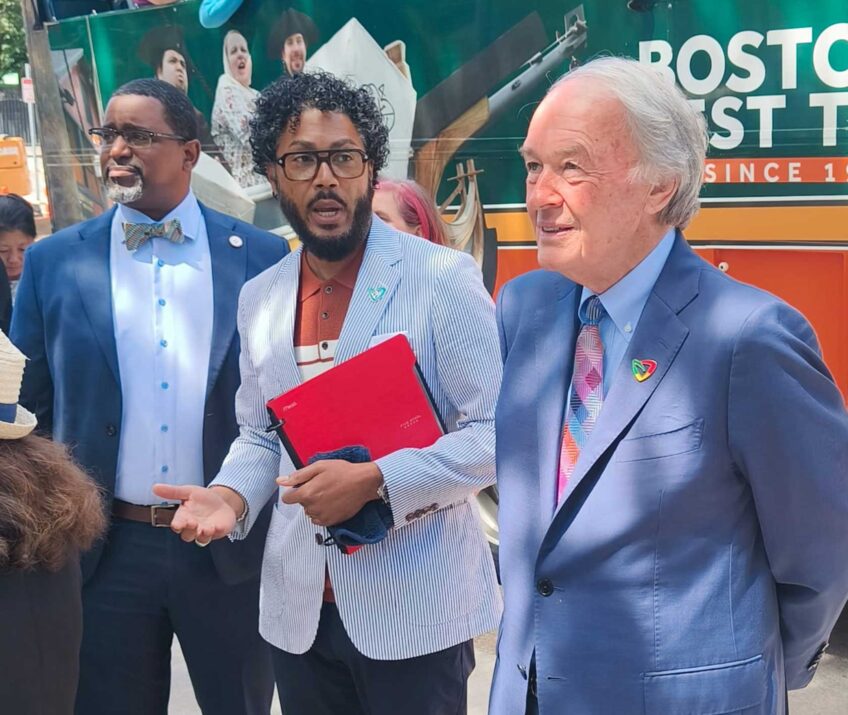
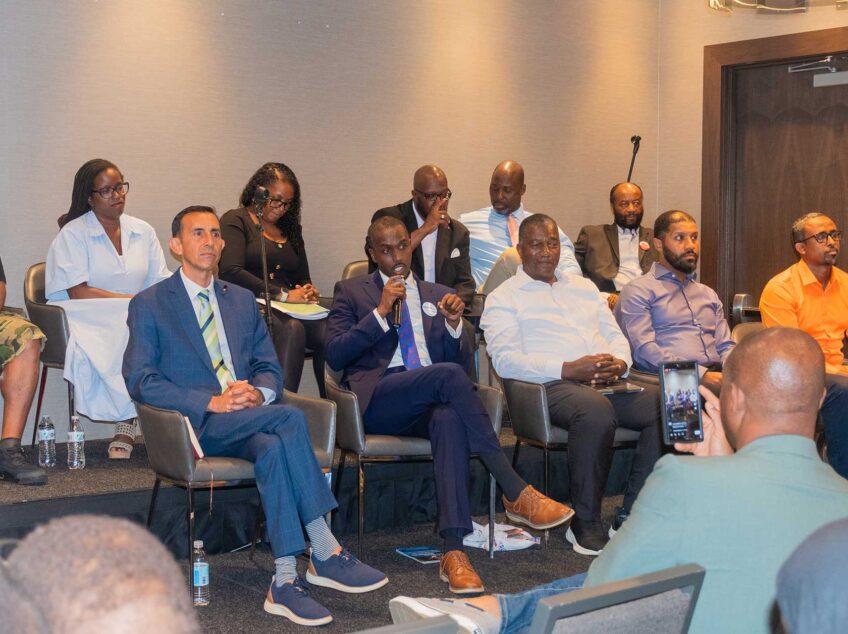
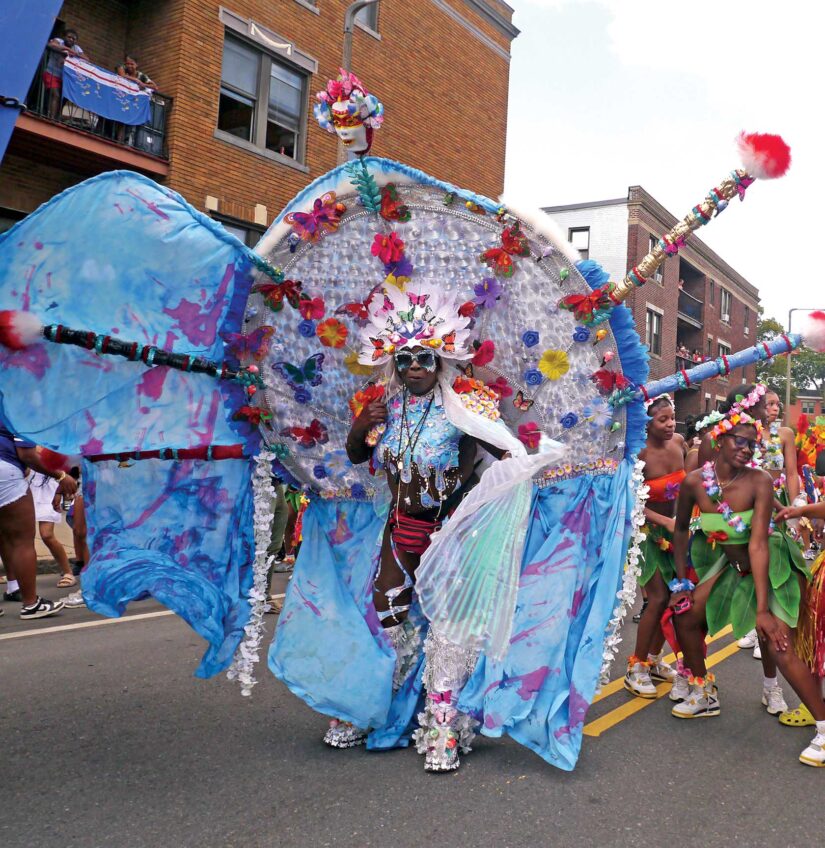
Leave a Reply
You must be logged in to post a comment.